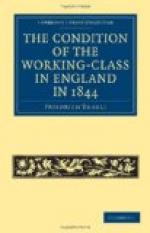If we cross Blackstone Edge or penetrate it with the railroad, we enter upon that classic soil on which English manufacture has achieved its masterwork and from which all labour movements emanate, namely, South Lancashire with its central city Manchester. Again we have beautiful hill country, sloping gently from the watershed westwards towards the Irish Sea, with the charming green valleys of the Ribble, the Irwell, the Mersey, and their tributaries, a country which, a hundred years ago chiefly swamp land, thinly populated, is now sown with towns and villages, and is the most densely populated strip of country in England. In Lancashire, and especially in Manchester, English manufacture finds at once its starting point and its centre. The Manchester Exchange is the thermometer for all the fluctuations of trade. The modern art of manufacture has reached its perfection in Manchester. In the cotton industry of South Lancashire, the application of the forces of Nature, the superseding of hand labour by machinery (especially by the power-loom and the self-acting mule), and the division of labour, are seen at the highest point; and, if we recognise in these three elements that which is characteristic of modern manufacture, we must confess that the cotton industry has remained in advance of all other branches of industry from the beginning down to the present day. The effects of modern manufacture upon the working-class must necessarily develop here most freely and perfectly, and the manufacturing proletariat present itself in its fullest classic perfection. The degradation to which the application of steam-power, machinery and the division of labour reduce the working-man, and the attempts of the proletariat to rise above this abasement, must likewise be carried to the highest point and with the fullest consciousness. Hence because Manchester is the classic type of a modern manufacturing town, and because I know it as intimately as my own native town, more intimately than most of its residents know it, we shall make a longer stay here.
The towns surrounding Manchester vary little from the central city, so far as the working-people’s quarters are concerned, except that the working-class forms, if possible, a larger proportion of their population. These towns are purely industrial and conduct all their business through Manchester upon which they are in every respect dependent, whence they are inhabited only by working-men and petty tradesmen, while Manchester has a very considerable commercial population, especially of commission and “respectable” retail dealers. Hence Bolton, Preston, Wigan, Bury, Rochdale, Middleton, Heywood, Oldham, Ashton, Stalybridge, Stockport, etc., though nearly all towns of thirty, fifty, seventy to ninety thousand inhabitants, are almost wholly working-people’s districts, interspersed only with factories, a few thoroughfares lined with shops, and a few lanes along which the gardens and houses of the manufacturers are scattered like villas.




